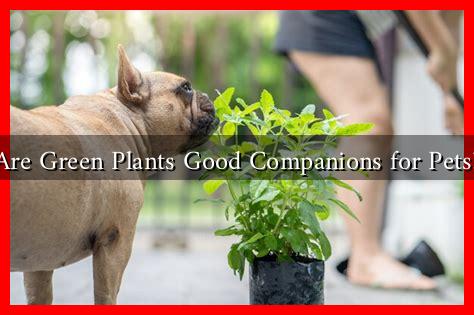-
Table of Contents
Are Green Plants Good Companions for Pets?
As pet owners, we often seek ways to enhance our furry friends’ living environments. One popular trend is incorporating green plants into our homes. But are these plants safe companions for our pets? This article explores the benefits and potential risks of having plants around pets, providing insights to help you make informed decisions.
The Benefits of Green Plants for Pets
Green plants can offer numerous advantages for both pets and their owners. Here are some key benefits:
- Improved Air Quality: Plants are known to purify the air by absorbing toxins and releasing oxygen. According to a study by NASA, certain houseplants can remove harmful substances like formaldehyde and benzene from the air, creating a healthier environment for both pets and humans.
- Stress Reduction: Studies have shown that the presence of plants can reduce stress and anxiety levels. For pets, a calmer environment can lead to better behavior and overall well-being.
- Natural Enrichment: Many pets enjoy exploring their surroundings. Plants can provide mental stimulation and physical activity, especially for curious cats and dogs who love to sniff and interact with their environment.
Choosing Pet-Safe Plants
While many plants are beneficial, not all are safe for pets. Some common houseplants can be toxic if ingested. Here are a few pet-friendly options:
- Spider Plant (Chlorophytum comosum): Non-toxic to cats and dogs, spider plants are easy to care for and can thrive in various conditions.
- Bamboo Palm (Chamaedorea seifrizii): This plant is safe for pets and can help improve indoor air quality.
- Boston Fern (Nephrolepis exaltata): A lush, non-toxic option that can add greenery to your home without posing a risk to your pets.
On the other hand, here are some common plants that are toxic to pets:
- Lilies: Highly toxic to cats, ingestion can lead to kidney failure.
- Philodendron: Can cause oral irritation and gastrointestinal distress in both cats and dogs.
- Aloe Vera: While beneficial for humans, it can cause vomiting and diarrhea in pets.
Case Studies and Statistics
According to the ASPCA’s Animal Poison Control Center, thousands of pets are affected by plant toxicity each year. In 2020 alone, they reported over 200,000 cases of plant-related poisonings. This statistic underscores the importance of being aware of the plants you bring into your home.
In a case study conducted by the University of California, researchers found that homes with pet-safe plants reported fewer instances of anxiety-related behaviors in pets. Owners noted that their pets seemed more relaxed and engaged when surrounded by greenery.
Creating a Safe Environment
To ensure that your home is a safe haven for both your pets and your plants, consider the following tips:
- Research Before You Buy: Always check if a plant is safe for your specific type of pet before introducing it to your home.
- Monitor Your Pets: Keep an eye on your pets’ behavior around plants. If they show excessive interest in chewing or digging, it may be best to relocate the plant.
- Educate Yourself: Familiarize yourself with the signs of plant poisoning, such as vomiting, diarrhea, or lethargy, and consult a veterinarian if you suspect your pet has ingested something harmful.
Conclusion
In conclusion, green plants can be excellent companions for pets when chosen wisely. They offer numerous benefits, including improved air quality and stress reduction. However, it is crucial to be aware of which plants are safe and which are toxic. By doing your research and creating a pet-friendly environment, you can enjoy the beauty of greenery in your home while ensuring the safety and well-being of your beloved pets.
For more information on pet-safe plants, you can visit the ASPCA’s website.

